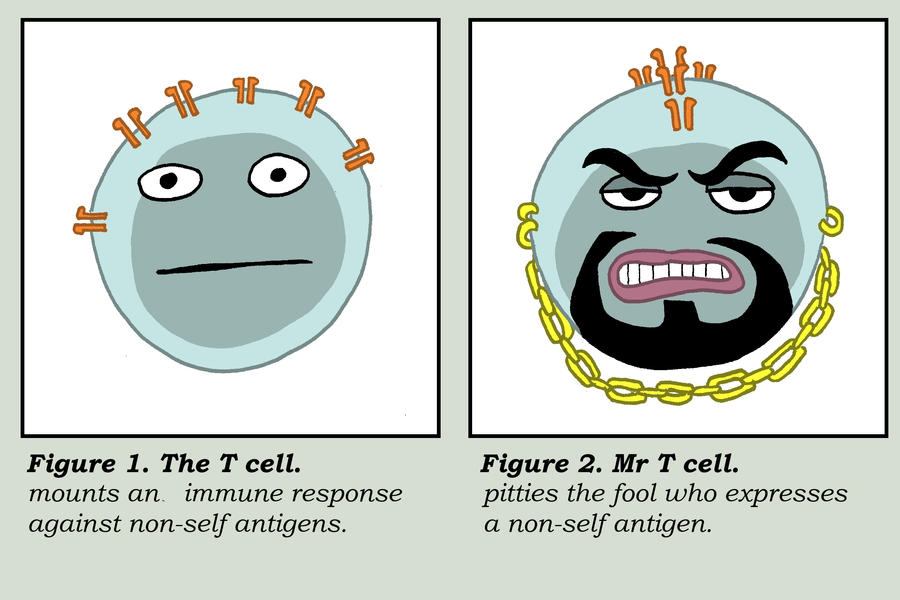A recent study focuses on the time
required for T cells to identify, interact with, and mount a response against
pathogens within the human body.
The life of
an infectious pathogen is not an easy one. Should a virus, bacterium, prion, or
fungus manage to make it past the body’s first line of defense – obstacles including
anatomical barriers such as the skin and physiological barriers like the hostile
low pH environment of the stomach – it still must face a barrage of innate and
adaptive immune responses before successfully establishing itself. Once a pathogen has entered the body, the innate
immune system – defined as the cells and mechanisms that defend the host
against foreign organisms in a non-specific manner - may recognize the non-self
intruder and induce an immune response. This eventually leads to the activation
of the adaptive immune system and, in turn, of white blood cells like T and B
lymphocytes (or T and B cells) which quickly identify and eliminate the
pathogen. It is the accuracy and speed of these cells’ responses that makes the
adaptive immune system so effective in protecting the body against infection. So the short answer is, yes, T cells do have a need for speed. To
contest to this, a recent study now suggests that that once a T cell senses an
antigen – a task that can take only a matter of seconds – it can decide the
fate of the invading microorganism within minutes.
This new
study, released in The Journal of
Immunology just a few months ago, tested T cells under various conditions
to judge their aptitude for identifying invading pathogens. According to the
authors, there are four factors that limit the ability of T cell to recognize
pathogens. These include:
- T lymphocyte bears a single T cell receptor (TCR). This means that any given T cell can only recognize a single antigen structure. Therefore T cells are very sensitive to interactions but are vastly outnumbered by antigen presenting cells (APCs)!
- Thousands of proteins can be used to generate the peptide - major histocompatibility complex (pMHC) on the invading cell surface. The T cell must be able to quickly recognize one to a few of these intricate complexes on the cell to identify it.
- Exposed cell pMHCs may differ by a few amino acids. Despite this, the TCR must still recognize them and be able to properly bind to trigger a T cell response.
- The TCR and pMHC complex is only ~ 14 nanometers in length. One nanometeris one-billionth of a meter, so these are miniscule complexes that must somehow closely interact in a stable way. This interaction is strongly dependent on the tiny movements made by the T cell membrane.
These limiting factors require that we
know two important things about T cells if we want to understand the speed and
specificity of the antigen detection process. Firstly, we need to know the how
often a T cell and an antigen presenting cell contact each other and for how
long. Secondly, we need to know if and how T cell membrane motions are altered
as a result of antigen detection.
To determine these features of the T cell
detection process, the authors used a technique called internal reflection
fluorescence microscopy or TIRFM. TIRFM is used to image the contact area between
the T cells and an antibody coated surface. While many of the authors previous
experiments used interference reflective microscopy (IRM) to study T
cell-antibody interactions, they found that using TIRFM allowed for better cell
imaging and, therefore, a more reliable method to view and time T cell
interactions. These TIRFM experiments
showed that the T cells were binding with and spreading across the antibody
coated surfaces within one minute of contact.
In addition, T cells were seen to associate with the antibodies for less
than 30 seconds before making their decision to trigger more coordinated cell
responses that result in the further spread of T cells in search for antibodies
and the production of proteins that would aid in an immune response. The authors also suggest that the tiny
membrane movements of the T cells are a way for the cell to rapidly test its
environment for antigens.
So what is so important about these
experiments? For one, they provide evidence of just how fast a T cell can identify
and respond to an antigen, thus giving us a better understanding of how quickly
and efficiently our immune system really works. Additionally, it provides the
basis for future experiments in which one could test how long after T
cell-antigen interaction other T cell triggered immune proteins and cell-cell
signaling would arise. It lays the base
for us to learn even more about the intricacies of our own body.
For general
information on the immune system, see: http://missinglink.ucsf.edu/lm/immunology_module/prologue/prologuehome.html
For
information on T-lymphocytes, see:
To see more
recent articles from the Journal of Immunology, see: http://www.jimmunol.org/content/current
Citations:
Primary
Source:
Brodovich A,
P Bongrand and A Pierres. T lymhpcytes sense antigens within seconds and make a
decision
within one minute. 29 July 2013. J Immunol. 191:2064-2071.
Secondary
Sources:
Medshitov R
and CA Janeway Jr. Decoding patterns of self and nonself by the innate immune
system. Science 12 April 2002 296:298-300 http://stke.sciencemag.org/cgi/reprint/sci;296/5566/298.pdf
Axelrod,
Daniel. (2001)Total Internal Reflection Fluorescence Microscopy in Cell
Biology. Blackwell Publishing Ltd
2:764- 774. http://dx.doi.org/10.1034/j.1600-0854.2001.21104.x
Images:

No comments:
Post a Comment